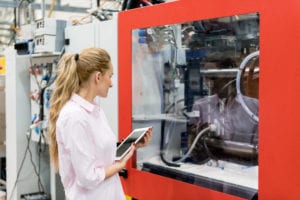 To remain competitive, modern logistics operations (including warehouses and distribution centers) must find innovative ways to generate scalable efficiencies around product storage, packaging, and delivery. High growth logistics firms distinguish themselves by their superior operational speed, scalability and agility to manage fast changes and continuously adapt to the market with the shortest delay. These companies are adopting open, digital automation technologies to gain these competitive advantages.
To remain competitive, modern logistics operations (including warehouses and distribution centers) must find innovative ways to generate scalable efficiencies around product storage, packaging, and delivery. High growth logistics firms distinguish themselves by their superior operational speed, scalability and agility to manage fast changes and continuously adapt to the market with the shortest delay. These companies are adopting open, digital automation technologies to gain these competitive advantages.
Big data analytics and service-level dashboards help logistics companies gain unprecedented insights into their transactional workflows. This helps them expand to more complex areas of logistics, such as omnichannel fulfillment (using digital platforms to support orders from many different purchasing channels, including online shopping carts, storefronts, or specialty marketplaces).
Achieving this success depends on technology platforms that can connect seamlessly, regardless of automation system manufacturer. Until recently, the effort to integrate conveyor, storage, and order preparation systems from different vendors represented a costly, long-term investment that was difficult to justify for most firms.
Universal automation, which is now possible due to the convergence of digital technologies and the IEC 61499 standard for automation portability and interoperability, is helping industrial enterprises to cost-effectively achieve long sought-after Industry 4.0 goals by introducing a vendor-agnostic, software-centric approach to automation.
Innovation with software-centric automation
Forward thinking automation manufacturers are aggressively supporting universal automation through the development of revolutionary offers such as Schneider Electric’s EcoStruxure™ Automation Expert, which decouples hardware from software, allowing application portability.
EcoStruxure Automation Expert provides logistics companies with the agility they need to meet changing market demands without the hardware dependency constraints of closed, proprietary automation systems. The concept introduces the logistics world to “plug-and-produce” automation components. In the past, the notion of “open” systems only meant using the same data format to exchange information Today, however, this is no longer enough. To fully realize the promise of Industry 4.0, industrial automation solutions can benefit from integrating into hardware-independent platforms that allow data exchange and reusability of programming objects, like conveyors, mergers, diverters, sorters, etc.
Universal automation generates distribution center performance benefits
EcoStruxure Automation Expert, the world’s first software-centric system based on universal automation, helps logistics organizations meet marketplace delivery speed challenges through the deployment of faster, more flexible conveyor, storage, and order preparation systems.
With EcoStruxure Automation Expert, logistics companies are:
- Driving to 100% engineering efficiency. Low/ no-value-added automation engineering tasks, as well as error-prone tasks, are automated, which eliminating duplication of efforts when moving from one engineering tool to another¾accelerating time to market and freeing engineers to innovate.
- Ready for 100% operational effectiveness. Bridges the division between IT and OT systems, so logistics firms can achieve operational effectiveness we could only dream of a decade ago.
- Now 100% future proof. A “wrap and reuse” approach can be used to support current systems while allowing full application portability for future migrations and expansions. A heterogeneous system management in a harmonized manner thanks to orchestration, we can make a “macro-object” out of third party equipment, and then instantiate it as many times it appears in the system.
At one international Schneider Electric distribution center, for example, EcoStruxure Automation Expert had been applied to auto-sorting lines. The facility has four input lines. In the past, if one of the lines experienced an electrical fault, all four lines would cease functioning, effectively shutting down the distribution center. However, since the facility deployed EcoStruxure Automation Expert, an agile automation architecture with multiple controllers, design engineers could choose where to run the application. This approach increased system availability by eliminating single points of Schneider Electric is also implementing EcoStruxure Automation Expert in its own Smart Distribution Center in Shanghai, China to reduce costs and improve efficiency. The software is decoupled from the hardware, modifying the conveying line to adapt as flow requirements change is easier and more cost-effective. With EcoStruxure Automation Expert, identifying the root cause of failure and troubleshooting is four times faster. And with 45% less products on the error line, throughput is increased by 5.3%.
To learn more about how EcoStruxure Automation Expert helps distribution centers and warehouses to implement step-change operational efficiency improvements, download the Schneider Electric e-guide “Unlocking New Levels of Logistics Agility.”



